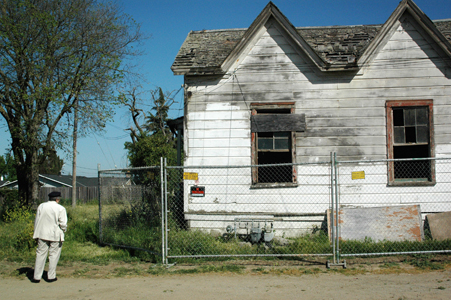
San Juan house huggers vie to save one of the oldest farm homes
in town
Like a good many of us, it’s seen better days. To town
historians of San Juan Bautista, it’s known as the Chalmers
Farmhouse, built by one of the town’s more prominent founding
fathers, but to the owners of the property it sits on, it’s a
dilapidated liability in the way of better of things to come.
San Juan house huggers vie to save one of the oldest farm homes in town
Like a good many of us, it’s seen better days.
To town historians of San Juan Bautista, it’s known as the Chalmers Farmhouse, built by one of the town’s more prominent founding fathers, but to the owners of the property it sits on, it’s a dilapidated liability in the way of better of things to come.
The two-bedroom abandoned four-gabled home, built in 1856, occupies a parcel on the northwest side of town, near Neil’s Market on Muckelemi Street. Members of San Juan’s Historical Resources Board say it only looks like it’s ready to fall apart because of the add-ons tacked onto the main structure in the 1940s – a front porch and a back room. It is owned by Guadalupe Rodrigues of San Jose, whose family grew up in the home during the 1930s and ’40s.
The next-door neighbors, who lived in the home in the last part of the millennium, don’t want to see it torn down either.
“It’s historic,” said Jose Luis Sanchez, who now lives in a much smaller, much more recently built house on the same parcel just yards away from the Chalmers Home. Sanchez and his wife Blanca lived in the Chalmers Home for years starting in the early 1970s. It’s unclear when they we’re asked to vacate.
“We really liked it. The owner didn’t want to rent it anymore, but I don’t think he wants to destroy it,” Sanchez added, speaking in Spanish.
Maybe so, but some half dozen Rodrigues family members recently attended a city council meeting to implore city leaders to allow them to take it down.
It started as a code enforcement violation, when a sheriff’s deputy told Rodrigues that he needed to “fix the issue.” Apparently, vagrants were holing up in the structure and small children were playing in and around it.
The city is now involved, and according to City Manager Jan McClintock, officials are caught between dealing with a liability and wanting to preserve a piece of history. Rodrigues has erected a cyclone fence around the structure, but the family wants to eventually tear it down in order to more easily sell the property.
Members of the Historic Resources Board inspected the home earlier this month and noted that the original home – without the front and back add-ons – is sound. The foundation is level and solid, made of redwood post and beam construction. The roof needs to be rebuilt.
The Chalmers House is a case study in the ongoing battle in the historic town between preservationists and local leaders – and landowners. The issue centers on how to balance housing needs and property rights over the need to preserve the town’s biggest asset and tourist draw: its history.
In 1850 George Chalmers and his brother Alex voyaged to California from Boston by ship, and then by land through the Panama Isthmus – long before the canal was built. Alex became a well-known architect of civic buildings in Watsonville, while George established a milling business in Castroville. The entire family was chock-full of renowned architects, and George, too, designed several of the still-existing buildings and homes of San Juan that now are on the National Register of Historic Places, including the Benjamin-Wilcox House and the Lorenz home on Monterey Street.
He built the Chalmers House and lived in it all is life, serving the town as a justice of the peace and as one of the village’s “trustees.” His sister married John Breen whose family came to California with the ill-fated Donner Party.
One idea that’s being floated now is to have the city buy the property and turn it into an historic village, possibly an historic agricultural museum. That way the town can preserve the house where it stands and possibly transfer other historic buildings to the site.
But as McClintock says, that will take money – a rarity in itself when it comes to the town coffers.









